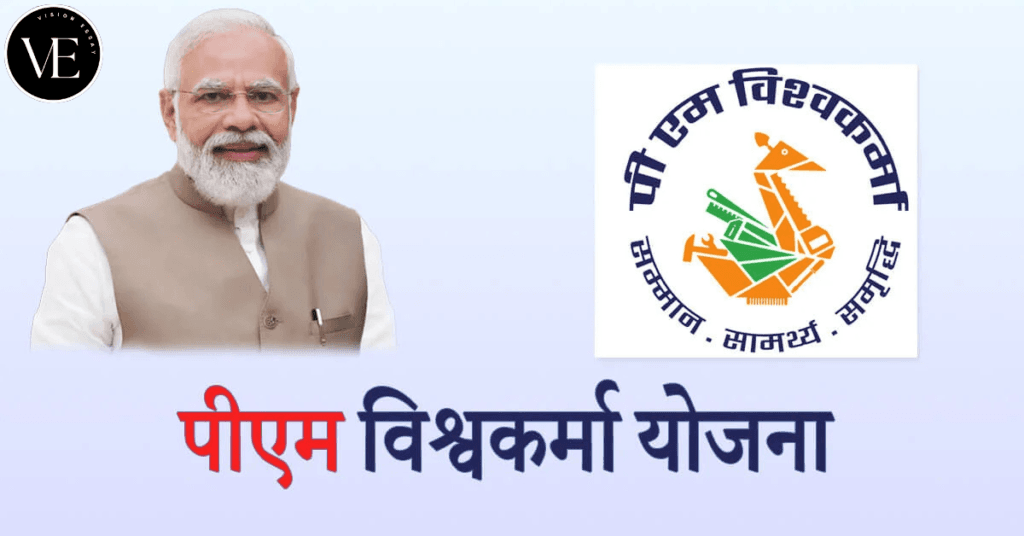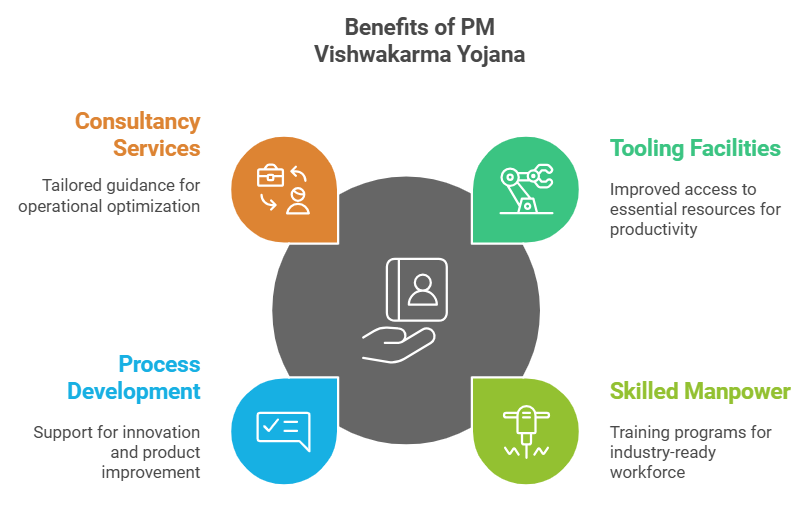PM Vishwakarma Yojana

Introduction
The PM Vishwakarma Yojana has made great progress in assisting traditional handicrafts and artists nationwide since its inception in 2023. Many applications were submitted, and many of them successfully finished the multi-step registration procedure.
What is the PM Vishwakarma Yojana?
PM Vishwakarma Yojana aims to support traditional artisans and craftsmen in India by enhancing their skills, providing financial assistance, and improving market access. Key features include:
- Skill development and capacity-building workshops.
- Access to modern tools and technology.
- Financial aid via loans at low interest rates.
- Support for branding, marketing, and quality certification.
- Focus on sustainable growth and self-reliance for artisans in sectors like carpentry, blacksmithing, and weaving.
What are Key Features of PM Vishwakarma Yojana?
The key features of the PM Vishwakarma Yojana include:
- Skill Development: Training and workshops to enhance skills and knowledge for traditional artisans and craftsmen.
- Financial Assistance: Access to loans at low interest rates to support business growth and modernize practices.
- Toolkits and Modern Equipment: Provision of updated tools and technology to improve efficiency.
- Market Access and Branding: Support for branding, marketing, and e-commerce to expand market reach.
- Quality Certification: Assistance in obtaining quality certifications to meet industry standards.
- Focus on Traditional Crafts: Targets artisans in fields like carpentry, blacksmithing, tailoring, weaving, and pottery.
- Sustainable Development: Promotes eco-friendly practices and self-reliance, ensuring long-term growth for artisans.
Who Can Benefit from PM Vishwakarma Yojana?
Beneficiaries of the PM Vishwakarma Yojana include:
- Traditional Artisans and Craftsmen: Individuals skilled in traditional crafts like carpentry, weaving, pottery, blacksmithing, tailoring, and more.
- Self-Employed Workers: Artisans working independently or in small groups who require financial and technical support.
- Rural and Urban Craftsmen: Craftspeople from both rural and urban areas aiming to expand their reach and market access.
- Unorganized Sector Workers: Workers without formal employment in artisanal trades who need skill development and formal recognition.
- Young Artisans: Young individuals interested in pursuing traditional crafts as a sustainable livelihood.
How PM Vishwakarma Yojana Works?
The PM Vishwakarma Yojana operates through a structured approach to support artisans and craftsmen:
- Identification of Beneficiaries: Eligible artisans and craftsmen are identified through a registration process at local levels.
- Skill Development Training: Beneficiaries receive skill enhancement and training to improve craft techniques and learn modern practices.
- Provision of Toolkits: Modern toolkits and equipment are provided to enhance productivity and quality.
- Financial Assistance: Access to loans at subsidized interest rates is given for business expansion and procurement of resources.
- Branding and Marketing Support: Assistance with branding, digital marketing, and selling through e-commerce platforms to increase visibility and sales.
- Quality Certification: Guidance and support for quality certification to meet industry standards, making products more marketable.
- Monitoring and Support: Regular monitoring and continuous support are provided to help artisans grow sustainably and independently.
What is the Impact of PM Vishwakarma Yojana on the Economy?
The PM Vishwakarma Yojana has a significant impact on the economy through:
- Job Creation: By supporting artisans and craftsmen, the scheme generates employment, especially in rural and semi-urban areas.
- Preservation of Traditional Skills: It helps sustain India’s cultural heritage, attracting domestic and international markets.
- Boost to Small Businesses: Financial and technical support enables small-scale artisans to expand, contributing to local economies.
- Increased Income Levels: Low-interest loans and market access raise artisans’ income, reducing poverty levels.
- Promotion of Exports: Quality certification and branding support help artisans reach global markets, increasing exports of traditional products.
- Inclusive Growth: Benefits for marginalized and unorganized sector workers promote equitable economic development.
- Sustainable Economic Growth: Eco-friendly practices encouraged by the scheme lead to long-term, sustainable growth in the artisan sector.
What are the challenges in implementation of PM Vishwakarma Yojana?
The implementation of the PM Vishwakarma Yojana faces several challenges:
- Identification and Reach: Identifying eligible artisans, especially in remote areas, can be challenging due to lack of formal records and documentation.
- Awareness and Participation: Many artisans are unaware of the scheme or may lack understanding of its benefits, limiting their participation.
- Limited Infrastructure: Rural areas often have limited access to training facilities, technology, and other resources needed to support artisans.
- Financial Literacy: Many artisans lack financial literacy, making it difficult for them to navigate loan processes and manage funds effectively.
- Market Access: Ensuring artisans gain sustainable access to national and global markets requires extensive support and a robust distribution network.
- Monitoring and Evaluation: Continuous monitoring of the scheme’s impact and progress is essential but challenging to implement effectively across diverse locations.
- Quality Standards: Helping artisans meet industry-quality standards can be difficult, requiring significant investment in training and resources.
- Digital Divide: Limited digital skills and internet access, especially in rural areas, hinder artisans’ participation in online marketing and e-commerce.
Comparing PM Vishwakarma Yojana with Other Schemes
- PM Vishwakarma Yojana vs. PM Mudra Yojana
- Focus: PM Vishwakarma Yojana specifically targets traditional artisans and craftsmen, while PM Mudra Yojana provides loans for small businesses across all sectors.
- Support Provided: Vishwakarma Yojana offers skill development, toolkits, and market support, whereas Mudra Yojana primarily provides financial loans without additional training or marketing support.
- PM Vishwakarma Yojana vs. Start-Up India
- Target Beneficiaries: PM Vishwakarma Yojana is geared toward artisans with traditional skills, while Start-Up India focuses on innovative, scalable business ideas, often in technology and manufacturing.
- Support Nature: Vishwakarma Yojana offers financial aid, modern equipment, and skill development for traditional crafts. Start-Up India provides tax exemptions, funding, and incubation for new-age businesses.
- PM Vishwakarma Yojana vs. Skill India Mission
- Scope of Skills: The Skill India Mission promotes a wide range of skills across sectors, whereas PM Vishwakarma Yojana is limited to traditional artisan skills.
- Outcomes: Vishwakarma Yojana provides market access and financial assistance, while Skill India focuses on skill certification and placement for a broad workforce.
- PM Vishwakarma Yojana vs. Shilpi Samriddhi Yojana
- Target Group: Both target traditional artisans, but PM Vishwakarma Yojana is broader in scale, covering multiple crafts, whereas Shilpi Samriddhi is specific to handloom and handicraft sectors.
- Implementation: Vishwakarma Yojana is more comprehensive, involving branding, quality certification, and digital market support, while Shilpi Samriddhi emphasizes artisan welfare and marketing assistance within specific sectors.
- PM Vishwakarma Yojana vs. Aatma Nirbhar Bharat Abhiyan
- Primary Goal: Both aim for self-reliance, but PM Vishwakarma Yojana focuses on empowering artisans, while Aatma Nirbhar Bharat is a larger initiative covering various sectors, from agriculture to manufacturing.
- Support Mechanism: Vishwakarma Yojana includes training, loans, and branding, whereas Aatma Nirbhar Bharat provides incentives, infrastructure development, and credit guarantees across industries.
Conclusion
In conclusion, the PM Vishwakarma Yojana plays a crucial role in uplifting traditional artisans by providing skill development, financial support, and enhanced market access. It fosters economic growth, preserves cultural heritage, and encourages sustainable practices. Despite challenges in implementation, its comprehensive approach aims to empower artisans, ensuring long-term self-reliance and boosting India’s economy by promoting traditional crafts both locally and globally.
Frequently Asked Questions(FAQs)
Who can apply for PM Vishwakarma Yojana?
Artisans from traditional crafts, including weaving, pottery, blacksmithing, and others, are eligible to apply.
How does PM Vishwakarma Yojana support artisans financially?
The scheme provides grants, low-interest loans, and subsidies for buying raw materials, upgrading tools, and meeting other financial needs.
Is skill training provided under PM Vishwakarma Yojana?
Yes, artisans can access training programs that enhance traditional skills and teach new ones, including digital and e-commerce skills.
What is the impact of PM Vishwakarma Yojana on rural development?
The scheme encourages rural employment, reducing migration to cities and strengthening local economies through traditional crafts.
Sources:
- https://pmvishwakarma.gov.in/
- https://www.amarujala.com/photo-gallery/utility/what-are-the-benefits-of-pm-vishwakarma-yojana-know-here-2024-11-08
- https://zeenews.india.com/hindi/business/pm-vishwakarma-yojana-modi-govt-to-give-3-lakh-on-5-percent-interest-know-how-to-apply/2500362
- https://www.jagran.com/editorial/apnibaat-artisans-and-craftsmen-got-support-new-life-to-18-traditional-businesses-from-pm-vishwakarma-yojana-23537407.html
- https://www.drishtiias.com/hindi/daily-updates/prelims-facts/pm-vishwakarma-yojana-1
- https://www.paisabazaar.com/hindi/business-loan/pm-vishwakarma-yojana/
- https://ndtv.in/india/jammu-and-kashmir-becomes-the-first-union-territory-to-implement-pradhan-mantri-vishwakarma-yojana-4791592

Leave a Reply